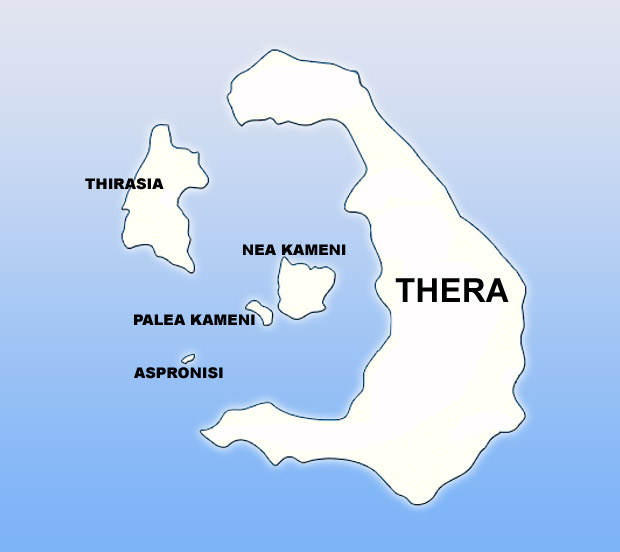Santorini was initially named as Strongyle, after its round shape (strongyle means “round”). This information has been noted by Herodotus who also lets us know that Strongyle was renamed as Calliste afterwards thanks to its incomparable beauty (calliste was used in ancient greek meaning “the most beautiful”). The first settlement of Calliste was of Phoenician origin, established there by Cadmus who left them on the island during his search for Europa who had been abducted by Zeus.

Thera map
The next settlers of Calliste were from Sparta (Lacedaemon). The founded a colony and named it after their leader Theras. This settlement turned Thera to a dorian colony just like Melos and Anaphe, contrary to the rest Cycladic islands that had been colonized by the Ionians. The present name of Santorini is a corruption of Santa Irene and it was first used by an Arab geographer named Al-Idrisi, in 1153. However, it can no more be considered as Strongyle given that it has been subjected to serious geological alterations due to the volcanic eruptions that took place in the past.
The most violent volcanic explosion of Santorini volcano occurred during the Bronze Age and it is know as the Minoan eruption. It destroyed a great part of Strongyle island and the remains of it compose the modern island known as Santorini. These remains surround a sea area where the caldera, created after the eruption, is located. The islands of Thera, Therasia and Aspronisi are at the periphery of the caldera. There are also two small islands in the middle of the caldera, known as Palea Kameni and Nea Kameni, which were shaped much later than the Minoan eruption and are two still active volcanic islands.
After the collision between Eurasia and Africa, a volcanic arc was created in the Aegean Sea. It was named as South Aegean Sea arc. It started from the greek mainland, in the areas of Attica and Argolis, it includes the islands Aegina, Poros, Melos, Santorini, Kos, Yali, Nisyros and it ends to Bodrum peninsula, Turkey. The collision of the two continents took place because the plate of Africa had been moving northwards until it crashed with the eurasiatic plate. The result was the sinking of the african plate gradually (5 cm per year).
This movement of the plates caused a lot of deformations in the lithosphere creating corridors in the earth’s crust, through which the magma kept ascending to the upper layers for a long time. The magma accumulations resulted to the creation of pouches containing magma which came in touch with the rocks of the earth’s crust. This altered the chemical and the natural composition of the magma, effecting on the equivalence of these systems of the lithosphere. High pressure levels in the pouches surpassed the pressure of the surrounding rocks and shattered them. When the gases of the magma were set free , the volcanic eruption began.
During the 20th century, 3 eruptions occurred in Santorini, the unique volcano of this arc that is still active.
